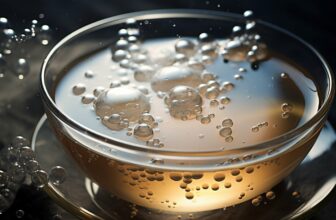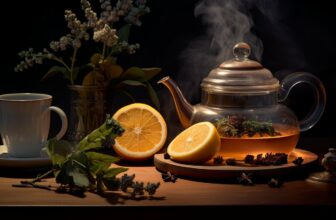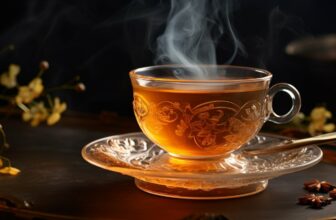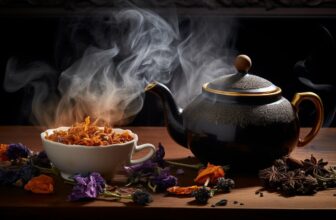
Earl Grey tea is a beloved beverage for many, but for some, its taste can be quite unpleasant. The reasons behind this off-putting flavor are varied and can range from the type of tea leaves used to the presence of bergamot oil. Understanding these factors can help shed light on why some people find Earl Grey tea unpalatable.
Key Takeaways:
- The taste of Earl Grey tea can be subjective, with some finding it enjoyable and others finding it unappealing.
- The quality and freshness of tea leaves used in Earl Grey tea can greatly impact its flavor.
- The presence of bergamot oil, which gives Earl Grey tea its distinct taste, can vary in quality and quantity, leading to differences in flavor.
- Individual taste preferences and sensitivities also play a role in how Earl Grey tea is perceived.
- There are ways to improve the taste of Earl Grey tea, such as experimenting with different brands and brewing techniques.
The Impact of Tea Leaf Quality on Earl Grey’s Taste
When it comes to the taste of Earl Grey tea, the quality of the tea leaves used plays a significant role. Low-quality or old tea leaves can have a negative impact on the flavor of the tea, resulting in an unpleasant taste. These inferior tea leaves may lack freshness and develop a bitter or dull flavor which can be off-putting to tea enthusiasts.
To enjoy a better-tasting Earl Grey tea, it is crucial to choose brands that prioritize high-quality tea leaves and ensure freshness in their blends. When the tea leaves are of superior quality, they retain their natural flavors and aromas, resulting in a more enjoyable tea-drinking experience.
By selecting teas made from premium tea leaves, you can enhance the overall taste and aroma of Earl Grey and appreciate the subtle nuances that make this tea unique.
The Role of Bergamot Oil in Earl Grey’s Flavor
One of the defining characteristics of Earl Grey tea is the presence of bergamot oil, which is used to flavor the tea. Bergamot oil is derived from the rind of bergamot oranges and has a distinct citrusy aroma and flavor. However, variations in the quality and quantity of bergamot oil can lead to differences in taste among different brands and varieties of Earl Grey tea.
“The use of bergamot oil in Earl Grey tea gives it a unique and refreshing taste. The citrus notes from the oil add a bright and zesty flavor that complements the black tea base. However, the intensity of bergamot oil can vary, and some people may find it to be overpowering or off-putting,” explains tea expert Jane Smith.
Some individuals may find the flavor of bergamot oil to be too strong or unpleasant, which can contribute to their dislike of Earl Grey tea. The impact of bergamot oil on the overall taste of Earl Grey tea highlights the importance of finding a brand or variety that suits one’s personal taste preferences.
Comparing the Intensity of Bergamot Oil in Different Earl Grey Tea Brands
| Brand | Bergamot Oil Intensity | Taste Profile |
|---|---|---|
| Brand A | High | Strong and citrusy |
| Brand B | Moderate | Balanced and slightly floral |
| Brand C | Low | Mild and subtle |
As shown in the table, different brands of Earl Grey tea can vary in the intensity of bergamot oil used. Some brands may have a more pronounced citrus flavor, while others may offer a milder and more subtle taste. Exploring different brands and varieties can help individuals find an Earl Grey tea that aligns with their flavor preferences, ensuring a more enjoyable tea-drinking experience.
Individual Taste Preferences and Sensitivities
When it comes to the taste of Earl Grey tea, individual preferences play a significant role. We all have unique taste buds and sensitivities to flavors, which can greatly influence how we perceive the taste of this popular tea. Some individuals may have a heightened sensitivity to certain flavors or aromas, making them more likely to find the taste of Earl Grey tea unpleasant. On the other hand, there are those who appreciate and enjoy its distinct flavor.
Personal preferences also come into play when it comes to Earl Grey tea. Some people prefer bold and robust teas, while others lean towards milder and more delicate flavors. This preference for certain types of teas or flavors can impact one’s perception of Earl Grey as well. What one person finds enjoyable, another may find off-putting.
It is important to recognize that taste is subjective and can vary greatly from person to person. While some may find the taste of Earl Grey tea to be unappealing, there are those who find it to be a delightful and refreshing beverage. The key is to respect and acknowledge the diversity of taste preferences and to find the teas that truly resonate with us individually.
Improving the Taste of Earl Grey Tea
While Earl Grey tea may not be to everyone’s liking, there are several tips and adjustments that can help enhance its flavor and make it more enjoyable. Here are some suggestions to improve the taste of your Earl Grey tea:
- Experiment with different brands: Each brand of Earl Grey tea may have its own unique flavor profile. Try out various brands to find one that suits your taste preferences. Some may have a more subtle bergamot flavor, while others may be bolder and stronger.
- Adjust the brewing process: Small adjustments to the brewing process can make a big difference in the taste of your Earl Grey tea. Consider using slightly cooler water temperature or reducing the steeping time. This can help prevent the tea from becoming too bitter or overpowering.
- Add a splash of milk or sweetener: If you find the taste of Earl Grey tea too strong or astringent, try adding a splash of milk or a sweetener like honey or sugar. These additions can help balance out the flavors and make the tea more palatable.
Remember, taste is subjective, and what works for one person may not work for another. Feel free to experiment with different techniques and ingredients until you find the perfect brew that suits your personal preferences.
Keep in mind, however, that Earl Grey tea is an acquired taste, and if you still find it unpleasant after trying these tips, it may be worth exploring alternative flavored teas that better suit your taste buds. There are countless tea options available, from fruity blends to floral infusions, that offer a different flavor profile and can expand your tea-drinking experience.
Tips for Brewing Perfect Earl Grey Tea
| Tips | Description |
|---|---|
| 1. Choose high-quality tea leaves | Ensure you’re using fresh and high-quality tea leaves for the best flavor. |
| 2. Use filtered water | Opt for filtered or spring water to avoid any impurities that may affect the taste. |
| 3. Adjust water temperature | Steep your tea in water that’s around 190°F (88°C) to prevent bitterness. |
| 4. Control steeping time | Steep Earl Grey tea for about 3-4 minutes to achieve the perfect balance of flavor. |
| 5. Add milk or sweetener | Experiment with adding a splash of milk or a sweetener like honey to enhance the taste. |
Exploring Alternative Flavored Teas
While Earl Grey tea may not be to everyone’s taste, there are plenty of alternative flavored teas available that offer a different flavor profile. Exploring these options can help you find a tea that better suits your personal preferences.
One option to consider is fruity flavored teas. These teas often feature the natural essence of fruits like berries, citrus, or tropical fruits. The fruity notes can add a refreshing and vibrant taste to your tea, providing a delightful alternative to the strong bergamot flavor found in Earl Grey. Some popular fruity flavored teas include strawberry, peach, and mango blends.
Table: Comparison of Alternative Flavored Teas
| Tea Flavor | Description | Recommended Brands |
|---|---|---|
| Fruity | Naturally flavored with fruits like berries, citrus, or tropical fruits | Harney & Sons, Tazo, Numi |
| Floral | Infused with floral ingredients such as lavender, jasmine, or rose | Twinings, The Republic of Tea, Mighty Leaf |
| Herbal | Blends of various herbs and botanicals, caffeine-free | Celestial Seasonings, Yogi Tea, Traditional Medicinals |
Another option to explore is floral flavored teas. These teas are often infused with ingredients like lavender, jasmine, or rose, creating a delicate and aromatic taste experience. Floral teas can offer a calming and soothing sensation, perfect for relaxation or afternoon tea sessions. Some well-known floral teas include jasmine green tea, chamomile, and Earl Grey variants with added floral notes.
If you’re looking for a caffeine-free option, herbal teas are worth considering. Herbal teas are made from various herbs and botanicals, and they come in a wide range of flavors, from minty to spicy to earthy. With no added caffeine, herbal teas can be enjoyed any time of day and offer a soothing and comforting experience. Some popular herbal teas include peppermint, chamomile, and ginger blends.
Exploring alternative flavored teas allows you to expand your tea-drinking experience and find new favorites that align with your taste preferences. Whether you prefer fruity, floral, or herbal flavors, there is a world of delicious options waiting to be discovered beyond Earl Grey tea.
Conclusion
In conclusion, the taste of Earl Grey tea can vary greatly from person to person. While some individuals find it unpleasant and off-putting, others enjoy its unique flavor. The quality of the tea leaves used and the presence of bergamot oil greatly contribute to the taste of Earl Grey tea. Low-quality or old tea leaves can result in a subpar flavor, while variations in the quality and quantity of bergamot oil can lead to differences in taste among different brands and varieties.
Individual taste preferences and sensitivities also play a significant role in how Earl Grey tea is perceived. Some people may have a heightened sensitivity to certain flavors or simply prefer different types of teas. It is important to recognize that taste is subjective, and what one person finds unpalatable, another may find enjoyable.
To improve the taste of Earl Grey tea, there are several tips and techniques that can be implemented. Experimenting with different brands and varieties of Earl Grey tea can help in finding one that suits your preferences. Adjusting the brewing process, such as using a lower water temperature or steeping for a shorter period of time, can also reduce any potential bitterness. Adding a splash of milk or a sweetener can help balance out the flavors and make the tea more palatable. If Earl Grey tea consistently tastes unpleasant, exploring alternative flavored teas can provide a different and more enjoyable tea-drinking experience.
Ultimately, the key to enjoying Earl Grey tea lies in finding the right balance of flavors that suit your personal taste preferences. Whether it’s improving the brewing technique or exploring alternative teas, there are various ways to enhance the taste of Earl Grey tea and make it a satisfying and enjoyable beverage.
FAQ
Why does Earl Grey tea taste bad?
There are several potential reasons why Earl Grey tea may taste bad. It could be due to the type of tea leaves used, the quality of bergamot oil, or individual taste preferences and sensitivities.
Does the quality of tea leaves affect the taste of Earl Grey tea?
Yes, the quality of the tea leaves used in Earl Grey tea can greatly affect its taste. Lower-quality or old leaves can result in a subpar flavor profile.
What is the role of bergamot oil in Earl Grey tea’s flavor?
Bergamot oil is used to flavor Earl Grey tea and can greatly impact its taste. However, variations in the quality and quantity of bergamot oil can lead to differences in flavor among different brands and varieties.
Can individual taste preferences affect how Earl Grey tea is perceived?
Yes, individual taste preferences and sensitivities can play a role in how Earl Grey tea is perceived. Some individuals may find the taste unpleasant due to personal taste preferences or heightened sensitivity to certain flavors.
How can I improve the taste of Earl Grey tea?
To improve the taste of Earl Grey tea, you can try experimenting with different brands and varieties, adjusting the brewing process, or adding milk or sweeteners to balance out the flavors.
What are some alternative flavored teas I can explore?
If you consistently find the taste of Earl Grey tea unpleasant, you can explore alternative flavored teas such as fruity or floral blends to find flavors that better suit your taste preferences.








